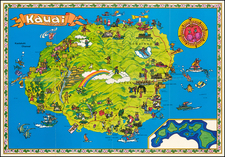Hawaii Triangulation Diagram, produced by the U.S. Department of Commerce Coast and Geodetic Survey under the direction of R.F.A. Studds in November 1953, is an intricate mapping, including soundings in fathoms at mean lower low water, and detailing a variety of landmarks ranging from church spires to mill stacks on the Big Island.
The 1950s marked a period of significant change and development in both the field of cartography and the Hawaiian Islands themselves. Post World War II, technological advancements led to more precise mapping techniques, such as triangulation, which allowed cartographers to create more accurate maps. Concurrently, Hawaii was experiencing industrial growth and urban expansion, particularly in the sugar industry, and the emergence of new infrastructural landmarks, which are recorded in this diagram.
This chart showcases specific soundings, base points, and landmarks including churches, mills, lighthouses, and sugar company stacks. It stands as a historical record, reflecting the landscape and industrial features of Hawaii in the mid-20th century. Mention of various structures from different years, such as the Hilo Sugar Co. Stack (1949) and Kohala Mill Stack (1948), adds a temporal dimension, reflecting the changes in the Hawaiian topography over time.
The triangulation diagram not only serves as a technical document for navigational and surveying purposes but also offers insight into the societal and industrial facets of the Hawaiian Islands during this era. It connects the practical function of maritime navigation with the historical evolution of the region, encapsulating a moment of transformation both in cartographic practice and the islands themselves.









![Mort de Cook [Death of Capt. James Cook]](https://storage.googleapis.com/raremaps/img/small/96645.jpg)
![[Aloha - Christmas Post Card]](https://storage.googleapis.com/raremaps/img/small/67516.jpg)
![Hawaiian Group or Sandwich Islands [with] New Zealand [and] Feejee Group, Society Island, Marquesas and Galapagos Islands](https://storage.googleapis.com/raremaps/img/small/80534.jpg)

![[ Oahu ]](https://storage.googleapis.com/raremaps/img/small/101961.jpg)
![[ Hawaii Discovered Before Cook? ] Iles Sandwich d'apres Cook / Groupe de la Mesa Tire de la Carte du Galion](https://storage.googleapis.com/raremaps/img/small/101268.jpg)